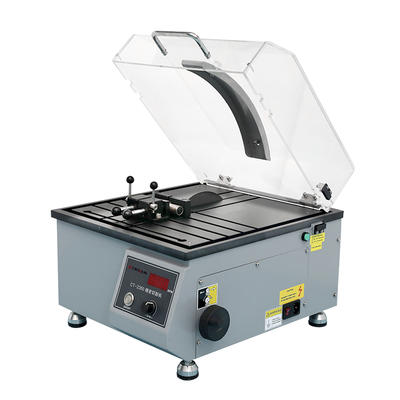In mechanical transmission mechanisms, belts and carbon brushes are common transmission and conductive elements. However, after long-term operation, the belt is prone to wear, resulting in reduced transmission accuracy and even equipment failure; and the carbon brush needs to be replaced due to wear, increasing the maintenance cost and workload of the equipment. To address these issues, the low-speed precision cutting machine adopts a belt-free and brushless design. This innovation brings significant advantages in many aspects.
The beltless design simplifies the transmission structure of the equipment and reduces energy loss and error accumulation during the transmission process. Traditional belt transmission often has elastic slip and skidding phenomena, resulting in reduced transmission accuracy. The beltless design achieves more precise transmission control through direct drive or gear transmission, thereby improving cutting accuracy and stability.
The brushless design avoids problems such as poor conductivity and spark discharge caused by carbon brush wear. In traditional motor design, the friction between the carbon brush and the commutator will produce wear and dust, which not only affects the performance of the motor but may also cause safety hazards. Brushless motors, on the other hand, use electronic commutation technology, which allows the current to be commutated without physical contact, thus avoiding these problems.
The beltless and brushless design plays an important role in improving the performance of low-speed precision cutting machines. Specifically, this design brings improvements in the following aspects:
Reduce operating noise: Traditional belt drives often produce loud noise, affecting the experimental environment of scientific researchers. The beltless design significantly reduces the operating noise of the equipment by reducing friction and vibration during the transmission process, providing researchers with a quieter and more comfortable experimental environment.
Improve transmission accuracy and stability: The beltless design achieves more precise transmission control through direct drive or gear transmission. This not only improves the cutting accuracy, but also enables the equipment to maintain stable performance during long-term operation, thus ensuring the continuity and reliability of scientific research experiments.
Reduce maintenance costs and workload: The brushless design avoids replacement and maintenance issues caused by carbon brush wear. This not only reduces the maintenance cost of equipment, but also reduces the workload of scientific researchers, allowing them to focus more on the scientific research experiments themselves.
Improve equipment reliability and life: The beltless and brushless design reduces the number of wearing parts in the equipment and improves the overall reliability and life of the equipment. This enables the low-speed precision cutting machine to operate stably in harsher working environments, providing scientific researchers with a more reliable means of sample preparation.
The beltless and brushless design not only improves the performance of low-speed precision cutting machines, but also significantly improves the efficiency of scientific research experiments. Specifically, this design brings improvements in the following aspects:
Shorten sample preparation time: The beltless and brushless design improves the transmission accuracy and stability of the equipment, making the cutting process more efficient and accurate. This shortens sample preparation time and improves the progress and efficiency of scientific research experiments.
Improve sample preparation quality: The belt-free and brushless design reduces the error accumulation and performance degradation of the equipment during long-term operation, making the sample preparation quality more stable and reliable. This improves the data accuracy and repeatability of scientific research experiments and provides researchers with a more reliable experimental basis.
Reduce experimental costs: The beltless and brushless design reduces the maintenance cost and workload of the equipment, thereby reducing the overall cost of scientific research experiments. This not only improves the utilization efficiency of scientific research funds, but also provides scientific researchers with more experimental resources and opportunities.
Improve experimental safety: The brushless design avoids potential safety hazards such as spark discharge caused by carbon brush wear, and improves the electrical safety of the equipment. This allows scientific researchers to operate and conduct research with greater peace of mind and concentration during the experiment.

 中文简体
中文简体 英语
英语 西班牙语
西班牙语 德语
德语



















